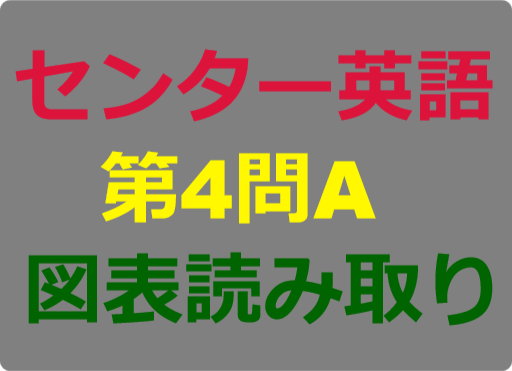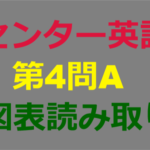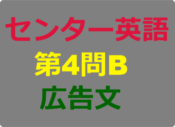2019年度 センター英語 追試験 第4問A 図表読み取り 問題&解説

大手予備校で中1から高3の基礎クラスから東大クラスまでほとんどのクラスを担当しました。映像授業にも多数出演経験あり。
元東海大非常勤講師。
「大学入試英語解く得!」は最高PV数 34,212 / 日
質・量ともに日本一分かりやすい大学入試英語対策ページを目指します!
資格:英検一級、通訳案内士(英語)、TOEIC950点
趣味:海外旅行、食べ歩き
特技:将棋アマ六段 (全国レーティング選手権優勝 1998)
元技術翻訳者、元富士通
2019年の追試験は文章が短めで、従来から1番よく見られる問題形式でした。
今回の内容
1. 2019年度 センター英語 追試験 第4問A 図表読み取り 問題
A 次の文章はある説明文の一部である。この文章と表を読み、下の問い(問1~4)の( 33~36 )に入れるのに最も適当なものを、それぞれ下の①~④のうちから一つずつ選べ。
When we sing or listen to music, our actions are often accompanied by movement. However, until recently, few researchers had looked closely at this relationship. To explore this, a group of researchers at a Belgian university focused on one type of movement, walking, and examined whether people could match their walking tempo with the tempo of music.
In the study, the researchers asked 20 participants to match their walking tempo to sound fragments presented in two sets. Each set consisted of 34 musical fragments with a length of 1 minute each and 6 metronome fragments with a length of 30 seconds each. The tempo of the fragments ranged from 50 BPM (beats per minute) to 190 BPM. The participants used a portable music player to listen to the fragments through headphones. The researchers recorded the walking tempo (the number of steps taken per minute) with a small recorder attached to one of the shoes worn by each participant. The participants were instructed to start walking at the tempo they perceived as each fragment began and to continue walking at that tempo. There was a short pause after each fragment. During each pause, they had to stop and wait for the next fragment.
As Table 1 shows, in most cases, the participants walked at the same tempo as the fragment (Equal). In other cases, the participants walked at twice the tempo (Double), at half the tempo (Half), or at a quarter of the tempo (Quarter). All of these four were considered to have matched the tempo. The researchers found that there were more cases where the participants’ walking tempo matched the tempo of the metronome fragments than the musical fragments. Furthermore, they looked at cases where the walking tempo did not match the tempo of the musical fragments. They found that between 106 BPM and 130 BPM, there were fewer of these cases than at faster or slower BPMs.
Table 1
Percentage of Matched and Unmatched Walking Tempo
| Equal | Double | Half | Quarter | Unmatched | |
| Musical fragments | 69.80 | 3.60 | 11.20 | 0.30 | 15.10 |
| Metronome fragments | 88.80 | 0.80 | 3.80 | ― | 6.70 |
Based on the results, the researchers suggested that people most easily match their walking tempo with the tempo of music when it is about 120 BPM. In the next section, research that examined whether the type of music affected the walking tempo will be discussed.
(Frederik Styns他(2007) Walking on Musicの一部を参考に作成。データは原文のまま。)
問1 The study required the participants to ( 33 ).
①listen to the fragments through public loudspeakers
②pause the recorder briefly after each fragment
③replay each set of fragments before beginning to walk
④stay still for a short period between each fragment
問2 According to Table 1, the participants ( 34 ).
①failed to match the tempo of the music in about 15% of cases
②failed to walk at the tempo for metronome fragments more than musical ones
③walked at a quarter of the music tempo in about 30 % of cases
④walked at double the tempo more than at half the tempo for metronome fragments
問3 The researchers found that there were more cases where the participants walked ( 35 ).
①at double the tempo than at half the tempo for musical and metronome fragments
②at the tempo equal to the BPM for musical fragments than for metronome ones
③with the tempo of music between 106 BPM and 130 BPM than at the other BPMs
④with the tempo when instructed to do so than when they were not
問4 What topic is most likely to follow the last paragraph? ( 36 ).
①A discussion of the type of metronome BPM used in this study
②A report investigating the effect of music preference on walking tempo
③A study examining walking tempo to different kinds of music
④An analysis of the effect of walking tempo on the selection of music
2. 2019年度 センター英語 追試験 第4問A 図表読み取り 解説
第4問A対策の記事はこちら。
第一段落の内容
When we sing or listen to music, our actions are often accompanied by movement. However, until recently, few researchers had looked closely at this relationship. To explore this, a group of researchers at a Belgian university focused on one type of movement, walking, and examined whether people could match their walking tempo with the tempo of music.
音楽には身体の動きを伴うが、この関係について詳しく調べた研究者はほとんどいなかった。
これを調べるために歩く速度が音楽の速度の合致するかどうか調べた。
本設問では第一段落の内容について問われていませんが、まずは第一段落の内容をしっかり読み取ることを習慣にしよう。
 しげT
しげT
第4問A 問1 (33)の解説
問1 The study required the participants to ( 33 ).
①listen to the fragments through public loudspeakers 公共の拡声器を通して(音楽の)断片を聞く
②pause the recorder briefly after each fragment 各断片の後は少しレコーダーを止める
③replay each set of fragments before beginning to walk 歩き始める前にそれぞれの断片のセットを再生する
④stay still for a short period between each fragment それぞれの断片と断片の間の短い時間じっとしたままでいる
In the study, the researchers asked 20 participants to match their walking tempo to sound fragments presented in two sets. Each set consisted of 34 musical fragments with a length of 1 minute each and 6 metronome fragments with a length of 30 seconds each. The tempo of the fragments ranged from 50 BPM (beats per minute) to 190 BPM. The participants used a portable music player to listen to the fragments through headphones. The researchers recorded the walking tempo (the number of steps taken per minute) with a small recorder attached to one of the shoes worn by each participant. The participants were instructed to start walking at the tempo they perceived as each fragment began and to continue walking at that tempo. There was a short pause after each fragment. During each pause, they had to stop and wait for the next fragment.
本設問の該当箇所は第二段落。
第二段落の最後に
「それぞれの(音楽の)断片の後には短い休止があり、その休止の間は止まって次の断片を待たなければならない。」とあるので、それを言い換えた④が正解。
①参加者が使うのは拡声器ではなく、携帯音楽プレーヤー。
②、③は記述なし。
第4問A 問2 (34)の解説
図表を読み取る定番の問題。
問2 According to Table 1, the participants ( 34 ).
①failed to match the tempo of the music in about 15% of cases
約15パーセントのケースで音楽の速度に合わせられなかった
②failed to walk at the tempo for metronome fragments more than musical ones
音楽の断片の速度よりメトロノームの断片の速度で歩けなかった
③walked at a quarter of the music tempo in about 30 % of cases
約30パーセントのケースで音楽の速度の4分の1で歩いた
④walked at double the tempo more than at half the tempo for metronome fragments
トロノームの断片で、半分の速度よりも2倍の速度で歩いた
Table 1
Percentage of Matched and Unmatched Walking Tempo
| Matched | |||||
| Equal | Double | Half | Quarter | Unmatched | |
| Musical fragments | 69.80 | 3.60 | 11.20 | 0.30 | 15.10 |
| Metronome fragments | 88.80 | 0.80 | 3.80 | ― | 6.70 |
①はTable1 のMusical fragments を見ると Unmatched が15.10とあるのでこれが正解。
②は本文にも記述があるが、表からも例えば”Equal”ではメトロノームの方が数値が高いので不正解。
③はTable1から30%ではなく0.3%
④はTable1からdoubleが0.8、halfが3.8でhalfの方が数値が高い。
第4問A 問3 (35)の解説
問3 The researchers found that there were more cases where the participants walked ( 35 ).
①at double the tempo than at half the tempo for musical and metronome fragments
音楽とメトロノームの断片で半分の速度よりも2倍の速度で
②at the tempo equal to the BPM for musical fragments than for metronome ones
メトロノームの断片より音楽の断片でBPMと等しい速度で
③with the tempo of music between 106 BPM and 130 BPM than at the other BPMs
他のBPMより106BPMと130BPMの間の音楽の速度に合わせて
④with the tempo when instructed to do so than when they were not
速度に合わせるように指示されない場合よりもそうするように指示された場合の方が速度に合わせて
正答の該当箇所は第三段落の最終部分。
As Table 1 shows, in most cases, the participants walked at the same tempo as the fragment (Equal). In other cases, the participants walked at twice the tempo (Double), at half the tempo (Half), or at a quarter of the tempo (Quarter). All of these four were considered to have matched the tempo. The researchers found that there were more cases where the participants’ walking tempo matched the tempo of the metronome fragments than the musical fragments. Furthermore, they looked at cases where the walking tempo did not match the tempo of the musical fragments. They found that between 106 BPM and 130 BPM, there were fewer of these cases than at faster or slower BPMs.
彼らは歩く速度が音楽の速度に合致しないケースを目にした。彼らは106BPMから130BPMの間は、より速いBPMやより遅いBPMよりもこれらのケースが少ない事が分かった。
これらのケースとは、歩く速度が音楽の速度に合致しないケース。
ここを言い換えると106BPMから130BPMの間は他の速度よりも歩く速度が音楽の速度に合致していたということなので、③が正解。
冷静に考えればそこまで難しくありませんが、解きづらい問題だったと思います。
 しげT
しげT
①と③はTable1から不正解だと分かる。
①表からhalfの方がdoubleの数値よりも高いので、半分の速度よりも2倍の速度ではなく、2倍の速度よりも半分の速度が正しい。
②は表から音楽の断片が69.80、メトロノームの断片が88.80なので、メトロノームの断片より音楽の断片でBPMと等しい速度ではなく、音楽の断片よりメトロノームの断片でBPMと等しい速度が正しい。
④は記述なし。
第4問A 問4 (36)の解説
2019年本試験には出題されませんでしたが、追試験は最終段落に続く内容を問ういつもの問題でした。
問4 What topic is most likely to follow the last paragraph? ( 36 ).
①A discussion of the type of metronome BPM used in this study
この調査で使われたメトロノームのBPMの種類についての議論
②A report investigating the effect of music preference on walking tempo
音楽の好みが歩行速度に与える影響を調査した報告
③A study examining walking tempo to different kinds of music
異なった種類の音楽の速度での歩行について調べた調査
④An analysis of the effect of walking tempo on the selection of music
歩行速度が音楽の選択に与える影響の分析
該当箇所はもちろん最終段落。
Based on the results, the researchers suggested that people most easily match their walking tempo with the tempo of music when it is about 120 BPM. In the next section, research that examined whether the type of music affected the walking tempo will be discussed.
「次のセクションでは、音楽の種類が歩く速度に影響を与えるかどうかについて調査した研究が議論される。」とあるので、それを言い換えた③が正解。
①はどこにも該当する記述なし。
②はどこにも音楽の好みに関する記述なし。
④はひっかけ。effect of A on B は「AがBに与える影響」。the effect of the selection of music on walking tempo なら正解になる。
大手予備校で中1から高3の基礎クラスから東大クラスまでほとんどのクラスを担当しました。映像授業にも多数出演経験あり。
元東海大非常勤講師。
「大学入試英語解く得!」は最高PV数 34,212 / 日
質・量ともに日本一分かりやすい大学入試英語対策ページを目指します!
資格:英検一級、通訳案内士(英語)、TOEIC950点
趣味:海外旅行、食べ歩き
特技:将棋アマ六段 (全国レーティング選手権優勝 1998)
元技術翻訳者、元富士通





